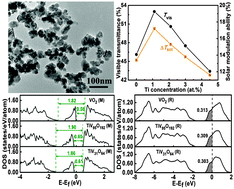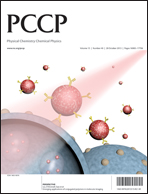The visible transmittance and solar modulation ability of VO2 flexible foils simultaneously improved by Ti doping: an optimization and first principle study†
Abstract
The Mott phase transition compound vanadium dioxide (VO2) shows promise as a thermochromic smart material for the improvement of energy efficiency and comfort in a number of applications. However, the use of VO2 has been restricted by its low visible transmittance (Tvis) and limited solar modulation ability (ΔTsol). Many efforts have been made to improve both of these limitations, but progress towards the optimization of one aspect has always come at the expense of the other. This paper reports that Ti doping results in the improvement of both the Tvis and ΔTsol of VO2-nanoparticle-derived flexible foils to the best levels yet reported. Compared with an undoped VO2 foil, a 15% increase (from 46.1% to 53%) in Tvis and a 28% increase (from 13.4% to 17.2%) in ΔTsol are achieved at a Ti doping level of 1.1%, representing the best performance reported for similar foils or films prepared using various methods. Only a defined doping level of less than 3% is beneficial for simultaneous improvement in Tvis and ΔTsol. First principle calculations suggest that an increase in the intrinsic band gap of VO2 (M) and the reduced electron density at Fermi level of VO2 (R) cooperate to result in the improvement of ΔTsol and that an enhancement in the optical band gap of VO2 (M) leads to the increase of Tvis.


 Please wait while we load your content...
Please wait while we load your content...